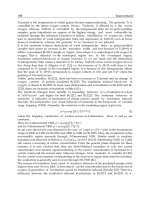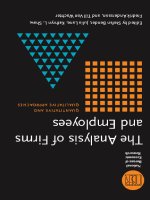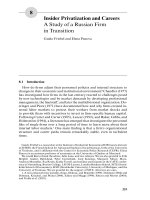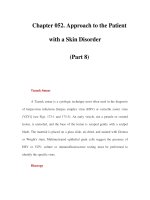The Welding of Aluminum & Its Alloys Part 8 ppt
Bạn đang xem bản rút gọn của tài liệu. Xem và tải ngay bản đầy đủ của tài liệu tại đây (285.67 KB, 20 trang )
7.4 Welding procedures and techniques
A set of outline welding procedures are given in Tables 7.2 and 7.3 for butt
welding using either argon or helium as the shielding gas, and guidance on
parameters for fillet welding is illustrated in Fig. 7.17. The parameters
quoted form a starting point from which to develop a procedure specifically
designed for the application. They are not to be regarded as hard and fast
rules. Also included as Table 7.4 are suggested weld preparations for MIG
welding of a range of plate thicknesses.
7.4.1 Arc starting
Because the wire is fed into the arc immediately that the arc is started
there can be no preheating of the joint as possible with TIG. This results
in shallow penetration and a humped weld bead on starting. Lack of
fusion defects are often encountered – a ‘cold start’ – and weld bead
shape may not be acceptable. To avoid these defects the welder should
strike the arc some 25mm ahead of the desired start point and then
move back to the weld start before beginning to weld forward at a normal
speed.
Arc starting may be achieved using a scratch start where the wire is
allowed to protrude from the contact tip by 10mm and brought to within
20mm of the surface. The trigger is operated and at the same time the
welding torch is moved to scrape the wire tip over the work surface. As
soon as the arc is established the power source senses the change in voltage
and starts the wire feed, the weld pool forms and welding can commence.
A ‘running’ start is one where the wire begins to feed as soon as the trigger
is operated and is short-circuited when it touches the workpiece, establish-
ing the arc. The current surge on short-circuiting may cause arcing within
the contact tip and spatter to adhere to the shroud and contact tip. These
can lead to wire feeding problems.
As mentioned earlier, the new inverter power sources have a facility for
a highly controlled arc start sequence.When the trigger is operated the wire
is fed at a slow and controlled rate until the wire tip touches the workpiece.
It is then retracted slightly and a pilot arc is ignited. Once this is stable the
current is increased at a controlled rate, the wire speed increased to the
desired feed rate and welding commences (Fig. 7.8). This gives a spatter-
free start and a low risk of lack of fusion defects, a major improvement over
the capabilities of older equipment.
MIG welding 135
Table 7.2 Suggested welding parameters – argon shielding
Thickness Root gap/ Included angle Backing Current Voltage No. of Filler diam. Travel speed
(mm) face (mm) (degrees) (A) (V) passes (mm) (mm/min)
1.6 nil Square Temporary 100 19 1 0.6 1000
2.5 Square Permanent 100 19 1 0.6 1000
2.4 nil Square Temporary 140 21 1 0.6 1000
3.2 Square Permanent 130 23 1 0.6 780
3.2 2.5 Square Temporary 160 24 1 1.2 780
5 Square Permanent 135 23 1 1.2 720
4 1.5 Square None 170 26 1 face 1.2 750
1 reverse
1.5/2.5 60 Temporary 160 27 1 1.2 750
single-V
4.5/1.5 60 Permanent 185 27 2 1.6 750
single-V
6.3 2.5 Square None 200 28 1 face 1.6 750
1 reverse
2.5/2.5 60 Temporary 185 27 2 1.6 750
single-V
6/1.5 60 Permanent 225 29 3 1.6 750
single-V
8 2.5/1.5 60 Temporary 245 29 2 1.6 750
single-V
4.5/nil 60 Permanent 255 29 3 1.6 750
single-V
10 2.5/4.5 90 None 290 29 1 face 1.6 750
single-V 1 reverse
2.5/2.5 60 Temporary 275 29 2 face 1.6 900
single-V 1 reverse
4.5/nil 60 Permanent 275 26 3 1.6 800/550
single-V
12.5 0.8/1.5 90 None 260/225 24/26 3 face 1.6 1050 root/
double- 3 reverse 800
V
2.5/1.5 60 Temporary 260 24 3 face 1.6 850 root/
single-V 1 reverse 550
4.5/nil 60 Permanent 270 24 3 1.6 550 root/
single-V 500
16 1.5/1.5 90 None 275 23/26 4 face 1.6 850 root/
double- 4 reverse 650
V
4.5/nil 60 Permanent 280 26 4 1.6 550 root/
single-V 450
20 1.5/1.5 90 None 255 root/ 22/26 4 face 1.6 900 root/
double-V 230 4 reverse 550
3/2.5 60 Temporary 350 29 4 face 2.4 1000
single-V 1 reverse
6/nil 60 Permanent 380 30 5 2.4 1000
single-V
25 1.5/1.5 90 None 255 root/ 22/26 6 face 1.6 600
double- 230 6 reverse
V
4/2.5 60 Temporary 350 29 2.4 1000
single-V
6/nil 60 Permanent 350 29 2.4 1000
single-V
1. Where two welding parameters are specified in one entry the first refers to the requirements for the first pass.
2. Where a reverse side weld is specified it is necessary to grind the reverse of the root pass to ensure a sound joint.
3. When making a double sided joint it is recommended that the weld passes are balanced to reduce distortion.
7.4.2 Torch positioning
The angle at which the torch is presented to the joint is important in that
an incorrect angle can result in air entrainment in the shielding gas and will
also affect the degree of penetration. Ideally the torch should be normal to
the surface and pointed forwards towards the direction of travel at an angle
of between 10° and 15° from the vertical, the forehand angle (Fig. 7.18).As
this angle increases penetration decreases and the amount of air entrained
in the shielding gas gradually increases.
Arc length cannot be set by adjusting the voltage since this is a function
of the resistance of the circuit as a whole.The arc length is set by the welder
using both sight and sound, a correct arc length being characterised by a
138 The welding of aluminium and its alloys
Table 7.3 Suggested welding parameters – helium shielding, flat position, large
diameter wires
Thickness Root Included Current Voltage No. of Filler Travel
(mm) gap/ angle (A) (V) passes diam. speed
face (degrees) (mm) (mm/min)
(mm)
50 0/5 70/2 550 32 2 each 4.8 250
sided side
75 0/10 30 650 30 3 each 5.6 250
6mm side
root R
0 100 150 200
Weld current
Fillet weld size – leg length (mm)
250 300 350
0
4
6
9
12
15
MIG welded fillet joints
Weld
runs
3–4 1.6 300–400
400–500
500–600
600–700
600–700
1.6
1.6
1.6
1.2
2–3
1
1
1
Wire
dia
mm
Travel
speed
mm/min
7.17 Suggested parameters for fillet welding – argon shielding.
Table 7.4 Suggested weld preparations for MIG welding
Material Edge preparation Remarks
thickness
(mm)
1.6–4.8mm A backing bar gives
greater control of
penetration
6.4–9.5mm Weld from both
sides, sighting Vs
recommended
4.8–12.7mm Suitable also for
positional welding,
when welded from
both sides
6.4–12.7mm Flat aluminium backing
bar optional. One
or more runs from
each side. Back chipping
recommended
after first run
6.4–19.1mm One or more runs
from one side,
depending on thickness.
Suitable also
for positional
welding
12.7–25.4mm Up to 1.6mm root
gap. One or more
runs from each side.
Back-chipping
recommended after
first run
12.7–25.4mm
12.7–25.4mm
60°
6.4mm
rad
3.2mm
60°
3.25mm
rad
4.8mm
2.4mm
70° to 90°
2.4mm
60°
3.25mm
rad
4.8mm
1.6–2.4mm
70° to 90°
T
/
3
T
70° to 90°
T
/
3
T
soft crackling sound similar to the sound of frying bacon. Too short an arc
sounds harsh and gives excessive spatter while a long arc has a humming
sound. The effect of changing the arc length is summarised in Table 7.5.
7.4.3 Ending the weld
If, when the weld is ended, the wire feed is abruptly stopped the weld pool
will freeze and a shrinkage crater will form. If the weld pool is small this
crater may be simply a shallow depression in the weld surface. In large weld
140 The welding of aluminium and its alloys
Work angle
45°
Forehand angle
90°
Work
angle 90°
Angle for fillet welding
An
g
le for butt weldin
g
Angle of torch related to travel direction. Ideally this
should be between 10° and 15°
Direction of torch travel
7.18 Torch position for MIG welding.
Table 7.5 Effect of arc length
Weld Bead Short Arc Long Arc
Excess metal High Flat
Penetration Deep Shallow
Width Narrow Wide
Porosity Higher Lower
Spatter Higher Lower
pools the crater may extend down into the weld to form an elongated pore
– piping porosity. As the weld continues to cool and contract then the asso-
ciated shrinkage stresses may cause hot short or crater cracks to form. Any
form of cracking is unacceptable and is to be avoided. Methods of elimi-
nating this defect include the following:
• The use of run-off tabs on which the weld can be terminated, the tab
being subsequently removed.
• Increasing the travel speed just before releasing the trigger.This causes
the weld pool to tail out over a distance. It requires a high measure of
skill on the part of the welder to produce acceptable results.
• Making a small number of brief stops and starts into the crater as the
weld cools. This adds filler metal to the crater.
• As the trigger on the torch is released the wire feed speed and the
welding current are ramped down over a period of time. The crater is
fed with progressively smaller amounts of molten filler metal as it forms,
resulting in the filling and elimination of the crater. This crater filling
facility is standard on modern equipment and is the preferred method
for avoiding piping porosity and crater cracks.
7.5 Mechanised and robotic welding
As MIG welding is a continuously fed wire process it is very easily mech-
anised. The torch, having been taken out of the welder’s hand, can be used
at welding currents limited only by the torch or power source and at higher
travel speeds than can be achieved with manual welding. A typical robot
MIG welding cell where the robot is interfaced with a manipulator
for increased flexibility and a pulsed MIG power source is illustrated in
Fig. 7.19. Greater consistency in operation means that more consistent weld
quality can be achieved with fewer defects. The advantages may be sum-
marised as follows:
• More consistent quality.
• More consistent and aesthetically acceptable bead shape.
• More consistent torch height and angle mean that gas coverage can be
better and the number of defects reduced.
• Fewer stops and starts, hence fewer defects.
• Higher welding speeds means less heat input, narrower heat affected
zones and less distortion.
• Higher welding current means deeper penetration and less need for
large weld preparations with fewer weld passes and therefore fewer
defects.
• Higher weld currents mean a hotter weld and reduced porosity.
MIG welding 141
• The above advantages mean that less welding time is required and
rework rates will be reduced, giving major improvements in productiv-
ity and reductions in cost.
• There is no need for the skilled welder required for manual welding, a
major advantage in view of the current shortage of highly skilled
welders.The loading and unloading of the welding cell can be performed
by unskilled workers, although knowledgeable and experienced engi-
neers will be needed to programme and maintain the equipment.
There are some disadvantages to mechanised and robotic welding. Weld
preparations need to be more accurate and consistent; more planning is
needed to realise fully the benefits; capital expenditure will be required to
purchase manipulators and handling equipment; maintenance costs may
well be higher than with manual equipment and the full benefits of high
deposition rates may only be achieved in the flat or horizontal–vertical posi-
tion. Despite these problems there is an increased usage of mechanised and
automated MIG equipment because of the financial benefits that may be
achieved.
142 The welding of aluminium and its alloys
7.19 Pulsed MIG power source interfaced with a robot and
manipulator. Courtesy TPS-Fronius Ltd.
To illustrate the cost benefits of mechanisation take as an example a
12mm thick butt weld. Made using manual MIG this would require four
passes to fill at a travel speed of around 175mm/min, a total weld time
of over 20 minutes per metre. A machine weld using argon as the shield
gas could be made in a single pass at around 480mm/min travel speed, a
total weld time of just over 2 minutes. Using helium as the shielding gas
would reduce this time even further.A set of typical parameters is given in
Table 7.6.
Because of the higher duty cycle achievable with mechanised or auto-
mated welding the power source, wire feeder and torch must be more robust
and rated higher than those required for manual welding.Welding currents
of 600 A or more may be used and this must also be borne in mind when
purchasing a power source. The torch manipulator, whether this is a robot,
a dedicated machine or simply a tractor carriage, must have sufficient power
to give steady and accurate motion at a uniform speed with repeatable,
precise positioning of the filler wire. Although at low welding currents con-
ventional manual equipment may be adapted for mechanisation by attach-
ing the torch to a manipulator, it is advisable to use water-cooled guns and
shielding gas shrouds designed to provide improved gas coverage.
7.6 Mechanised electro-gas welding
A technique described as electro-gas welding was developed by the Alcan
Company in the late 1960s but seemed to drop out of favour in the late
1990s, which is surprising when the advantages of the process are consid-
ered. The weld may only be carried out in the vertical-up (PF) position but
is capable of welding both square edge butt joints and fillet welds with
throats of up to 20mm in a single pass.
To operate successfully the process uses a long arc directed to the back
of the penetration cavity. This provides a deeply penetrating arc that
MIG welding 143
Table 7.6 High current mechanised MIG parameters
Thickness Joint type Backing Current Voltage Travel speed
(mm) (A) (V) (mm/min)
12 Square edge Temporary 400 26.5 380
12 Square edge Permanent 450 29 350
19 Square edge Temporary 540 33 275
19 Square edge Two sided 465 29.5 380
25 Square edge Two sided 540 33 275
32 Square edge Two sided 530 33 275
(6mm sight V)
operates in the space above the weld pool. The pool fills the cavity below
the arc, solidifying as the torch is traversed vertically up the joint line. The
molten pool is retained in position and moulded to shape by a graphite shoe
attached to and following immediately behind the welding torch.
The process utilises a drooping characteristic power source capable of
providing 600 A at 100% duty cycle coupled to a water-cooled machine
torch. The torch is mounted on a vertical travelling carriage at an angle of
15° from the horizontal. The gas shroud should be at least 25mm in diam-
eter and the tip of the contact tube should be flush with the shroud.
For butt welding the graphite shoe is made from a flat plate shaped with
a groove to mould the cap, flared out towards the top of the shoe where the
weld pool is formed.The fillet weld mould is provided with a pair of ‘wings’
set back to press against the plates to form the fillet. In both cases the shoe
is held against the plates by spring pressure. The shoe must be long enough
to hold the molten metal in place until it has solidified – in the region of
100mm may be regarded as sufficient. It has been found that heating the
shoe to 350°C before commencing welding assists in preventing fouling of
the shoe with parent metal.
During welding the arc must be prevented from arcing onto the weld pool
or the graphite shoe. This requires careful control of the wire position and
the wire feed speed, as a balance must be achieved between the volume of
metal being fed into the pool, the volume of the mould and the traverse
speed.
7.7 MIG spot welding
MIG spot welding may be used to lap weld sheets together by melting
through the top sheet and fusing into the bottom sheet without moving the
torch. The equipment used for spot welding is essentially the same as that
used for conventional MIG, using the same power source, wire feeder and
welding torch. The torch, however, is equipped with a modified gas shroud
that enables the shroud to be positioned directly on the surface to be
welded (Fig. 7.20). The shroud is designed to hold the torch at the correct
arc length and is castellated such that the shield gas may escape. The power
source is provided with a timer so that when the torch trigger is pulled a
pre-weld purge gas flow is established, the arc burns for a pre-set time and
there is a timed and controlled weld termination. The pressure applied by
positioning the torch assists in bringing the two plate surfaces together.
Because of this degree of control the process may be used by semi-skilled
personnel with an appropriate amount of training.
The process may be operated in two modes: (a) by spot welding with the
weld pool penetrating through the top plate and fusing into the lower one
or (b) by plug welding where a hole is drilled in the upper plate to enable
144 The welding of aluminium and its alloys
the arc to operate directly on the lower plate so that full fusion can be
achieved. Plug welding is generally required when the top sheet thickness
exceeds 3mm. The size of the drilled hole is important in that this deter-
mines the size of the weld nugget and the diameter should be typically
between 1.5 and 2 times the top sheet thickness. Typical welding parame-
ters are given in Table 7.7.
Of the shield gases argon is the preferred choice as it produces a deep,
narrow penetration. Argon also provides better arc cleaning than helium,
important in maintaining low levels of oxide entrapment. Arc stability is
also superior. Surface preparation is important, cleanliness being crucial to
defect-free welds. As with butt welds, degreasing and stainless steel wire
brushing, supplemented by scraping if a hole is drilled, are most important.
MIG welding 145
Contact tip
Filler wire
Castellated
gas shroud
Downward
force
Weld pool
7.20 Schematic of the MIG spot welding process.
Table 7.7 Spot and plug welding parameters
Top plate Bottom plate Preparation Current Voltage Weld time
(mm) (mm) (A) (V) (s)
1.0 1.0 Cu backed 320 23 0.8
1.0 2.5 Cu backed 325 23 1.0
1.5 1.5 Cu backed 335 24 1.0
1.5 2.5 Cu backed 350 24 1.2
1.5 3.2 None 240 23 2.0
2.5 2.5 9mm hole 180 26 2.5
2.5 6.3 None 350 24 2.0
3.2 3.2 10mm hole 260 25 2.3
6.4 12.5 11mm hole 400 24 2.0
6.4 12.5 13mm hole 370 25 2.5
Welding can be carried out with equal ease with the plate in the
horizontal, vertical or overhead position although in other than the flat
position the welding time needs to be reduced from that listed in Table 7.7.
This may result, however, in an increased level of porosity. Other defects
include cracking, lack of fusion and burn-through. To prevent and control
burn-through a temporary backing bar may be used. Fit up is important and
for the highest strength the gap between the plates should be as small as
possible.
146 The welding of aluminium and its alloys
8.1 Introduction
While MIG and TIG welding may be regarded as the most frequently used
processes for the joining of aluminium and its alloys there are a large
number of other processes that are equally useful and are regularly
employed although perhaps in rather more specialised applications than
the conventional fusion welding processes. Some of these processes are
discussed here.
8.2 Plasma-arc welding
As described in Section 4.3 a modification to the TIG welding torch enables
a strong plasma jet to be produced that has some very desirable features
for both welding and cutting. Despite these advantages the process found
little application for the welding of aluminium when DC electrode nega-
tive or electrode positive were used because of extensive lack of fusion
defects. Alternating current gave no better results as high currents were
required, resulting in rapid electrode deterioration. The pulsing of the
current also caused weld pool instability, poor bead shape and lack of fusion
defects. These limitations were overcome with the development of square
wave power sources, already mentioned in Chapter 6, since which time
plasma-TIG has become accepted as a viable production process.
8.2.1 Plasma-TIG welding
8.2.1.1 Main characteristics
As mentioned above, the basic principles of the plasma-TIG process (EN
process number 15) have been covered in Section 4.3 which describes the
use of the heat from the plasma-arc for cutting purposes. For welding the
transferred arc plasma-jet is used as the heat source, the major difference
8
Other welding processes
147
from cutting being that no cutting gas is introduced to blow away the molten
metal (Fig. 8.1).
There are a number of advantages that plasma-TIG has compared with
conventional TIG mainly because of the cylindrical and constricted plasma
column.This provides less sensitivity to process variables than with the TIG
process. The constricted plasma column means that the heat is confined to
a smaller area than with TIG, enabling a very stable controllable arc to be
produced at currents as low as 0.1A. It is possible to weld without keyhol-
ing at thicknesses less than 2.5mm but there is little advantage to be gained
in terms of productivity over TIG.The keyholing technique may be used in
manual welding but it is more common to find it in mechanised or auto-
mated applications.
The plasma is strongly directional and can be pointed in any given direc-
tion even at very low currents. The cylindrical plasma column means that
heat input is constant irrespective of torch to workpiece distance, unlike
TIG with its conical arc.The tungsten electrode is recessed inside the torch
nozzle, making tungsten contamination an impossibility. There is also an
increase in weld quality with a reduced risk of porosity and distortion.
Higher welding currents enable material as thick as 15mm to be welded
positionally in a single pass with a square edge weld preparation using the
keyhole technique although in the flat position the maximum thickness is
limited to around 8mm without filler metal.
The process may be used in a melt-in mode using techniques similar to
those that would be used for TIG. The weld may be made autogenously in
those alloys that are crack-resistant; filler wire may be added to those that
are crack-sensitive. This wire can be added manually but torches are avail-
148 The welding of aluminium and its alloys
Tungsten electrode
Cooling water
Plasma gas
Shielding gas
Nozzle
Power
source
–VE
+VE
Workpiece
8.1 Principles of the plasma-TIG transferred arc torch. Courtesy of TWI
Ltd.
able equipped with automatic wire feed.This latter feature, however, makes
the process sensitive to stand-off distance. A change in the stand-off will
affect the position in which the wire enters the weld pool and this may give
variable weld quality.
The problem with conventional plasma-TIG is that the process normally
operates on DC negative polarity so that no cathodic cleaning takes place,
an obvious disadvantage when welding aluminium. Welding without the
facility to remove the oxide layer causes porosity.To overcome this a devel-
opment of the DC positive plasma-TIG process, the variable polarity
plasma process was developed.This utilises a square wave form with a suit-
able balance of the DC negative and positive components to provide both
melting and adequate oxide removal.
8.2.1.2 Variable polarity plasma-arc process principles
For the plasma to form, a pilot arc is first established within the torch
annulus by means of a high-frequency discharge. As the plasma gas passes
through this HF discharge it is ionised, allowing the welding current to flow
and the plasma flame to be established. The plasma gas flow is very small,
typically 1–5 litres/min. This is insufficient to provide adequate shielding
and therefore needs to be supplemented with a secondary shield gas. The
gases are generally high-purity argon similar in quality to that used for TIG
welding, but helium or argon–helium mixtures may also be used.
Arc stability and oxide removal are better than with TIG or MIG pro-
vided that the appropriate wave form is used. It is necessary to tailor each
wave form and the balance between DC electrode positive and DC
electrode negative to the individual alloy composition. Typical wave form
characteristics for the keyhole welding of a number of alloys are given
in Table 8.1. It is worth remembering that if the keyhole technique is
used autogenously the alloys must be capable of providing crack-free weld
metal.
Other welding processes 149
Table 8.1 Typical parameters for keyhole welding of 6.5mm thick Al alloys
Aluminium grade Electrode negative Electrode positive
Current (A) Time (ms) Current (A) Time (ms)
2219 140 20 185 3
3001 155 20 220 3
5086 145 20 180 3
5456 130 20 185 3
6061 150 20 210 3
Over 8mm thick it is necessary to weld with a prepared edge and filler
wire although in the vertical-up (PF) position material as much as 16mm
thick can be welded.The diameter of the filler wire is the same as would be
used for TIG welding, generally 1.6 or 2.4mm diameter.
8.2.2 Plasma-MIG welding
Plasma-MIG welding utilises a MIG wire, generally 1.6mm in diameter, fed
through a plasma-arc torch. This allows a higher combined welding current
to be used than for the MIG wire alone with a high current density and a
higher deposition rate than MIG being achieved. This enables welding
speeds to be increased giving lower heat input and narrower heat affected
zones with better mechanical properties.
The process is generally used in a mechanised or automated application
although it is possible to use it in a semi-automatic manual mode.The thick-
ness that has been welded ranges from 6mm to 60mm.
8.3 Laser welding
Laser welding is being used increasingly in both the automotive and aero-
space industries for the welding of a range of materials (Fig. 8.2). The laser
welding of aluminium and its alloys has, however, presented problems to
the welding engineer. Poor coupling of the beam with the parent metal,
high thermal conductivity, high reflectivity and low boiling point alloying
elements have, until relatively recently, prevented the achievement of con-
sistent weld quality.
150 The welding of aluminium and its alloys
8.2 Laser weld of thin plate. Courtesy of TWI Ltd.
The wavelength of the laser light affects the coupling – the absorption of
the beam energy by the metal being cut or welded. As the wavelength
increases the coupling becomes poorer and this is a particular problem with
aluminium and its alloys. The wavelength of light from a CO
2
laser is
10.6mm, that of a Nd-YAG laser 1.06mm – the solid state laser is therefore
better suited to the welding of aluminium. Development work, carried out
mostly for the automotive industry on sheet metal, has also been of assis-
tance in minimising these problems by improved focusing of the beam with
both types of laser. One of the earliest applications for this development is
the Audi A2 which has some 30 metres of laser welds in its bodywork. The
main reason for the improvement in laser weldability has been the ability
to achieve high-power densities, typically above 40kW/mm
2
, with both the
Nd-YAG solid state and CO
2
gas lasers. As a process, laser welding offers
the advantages of a concentrated, high-energy density heat source. This
power density enables the weld to be made in the keyhole mode (Fig. 8.3),
improving the absorption of the laser beam due to reflections within the
cavity. The deeply penetrating keyhole weld produces very narrow heat
affected zones, minimising both distortion and the loss of strength in the
HAZ of the work or precipitation-hardened alloys and reducing the loss of
low boiling point alloying elements such as magnesium.
The low boiling point elements, however, assist in establishing a stable
keyhole. The high-energy beam also enables very fast welding speeds to be
achieved, speeds of 2 metres per minute with a 2 kW Nd-YAG and 5–6
metres per minute with a 5kW CO
2
laser in 2mm thick sheet being easily
Other welding processes 151
Focused
laser beam
Molten metal flows
round keyhole and
recombines to form
weld
'Chevron' weld
bead pattern
Weld direction
8.3 Principle of laser welding. Courtesy of TWI Ltd.
attainable.The main welding parameter is the laser power which determines
both the depth of penetration and the travel speed. Other variables are the
position of the focal point, generally at the upper surface, wire diameter
and feed speed and weld gap.
Defects in laser welded joints are similar to those encountered in welds
made by other fusion welding processes. Porosity is caused by hydrogen
from the environment, dissolved in the parent metal, contained in the oxide
film or from an unstable keyhole condition. The solution to this problem is
careful surface preparation including pickling and scraping, gas shielding
and the use of adequate power to ensure the creation of a stable keyhole.
Although most of the non-heat-treatable alloys are capable of being welded
successfully, hot cracking may be encountered, particularly in those alloys
that are sensitive. This can be reduced or eliminated by the addition of a
suitable filler wire. The last difficulty is caused by the low viscosity of the
molten weld metal. This causes the problem of ‘drop-through’, where the
weld metal falls out of the joint when welds are made in the flat position.
This problem can be overcome by welding in the horizontal–vertical (PC)
position.
8.3.1 CO
2
laser welding
As mentioned above improved focusing has enabled very concentrated
beams with energy densities above 40kJ/mm
2
to be produced.This has been
achieved by using parabolic reflectors or transmissive systems with a focal
length of around 150mm. The alloy content affects the energy required to
achieve a keyhole with increasing levels of zinc or magnesium requiring less
energy.This is attributed to the low vaporisation temperature of these alloy-
ing elements assisting in the formation of the keyhole. One corollary of this
is that higher welding speeds are possible in those alloys with the higher
magnesium contents.
Helium gas shielding of both the root and face of the weld is re-
commended for the higher magnesium-containing alloys such as 5083
(Al4.5Mg). Over some 3mm in thickness a jet of helium, supplementing
the shielding gas, directed at the weld pool also gives improved weld
appearance. Helium–argon mixture and pure argon gas have also been
used with acceptable results although with a reduced parameter tolerance
box.
Wire additions may be used to increase the resistance to hot cracking in
those alloys that cannot be autogenously welded such as the 6XXX and
7XXX series of alloys.Wire additions are also beneficial in coping with gaps,
a 1.2mm wire can be used to fill gaps of up to 1.2mm. Wire diameters may
be between 0.8 and 1.2mm. Feeding the wire into the leading edge of the
152 The welding of aluminium and its alloys
weld pool at an angle of around 45° will improve the bead shape on both
root and cap.
The majority of welding has been carried out on butt welded sheets (Fig.
8.4).The joint between the sheets results in an increase in beam absorption
and improved keyhole stability compared with bead-on-plate welds. Good
fit-up is necessary for autogenous welding if undercut is to be avoided.This
requires either square machined or high-quality guillotined edges. Where
lower-quality edges are produced, wire additions can be used to cope with
any gaps. Where extrusions are welded, a small ‘V’ on the weld face aids in
penetration by reflecting laser light within the preparation.
8.3.2 Nd-YAG solid state welding
The wavelength of the light from solid state lasers is only a tenth of the
wavelength of light from a gas laser. It is believed that this permits better
coupling of the beam with the parent metal. The short wavelength also
enables the laser light to be transmitted via fibre optics, rather than by the
use of the copper mirrors that are used to manipulate the light from the
CO
2
laser (Fig. 8.5).This gives greatly improved flexibility, allowing the use
of a robot to move and position the beam. Most of the techniques used for
CO
2
welding apply to the solid state laser and, as with the CO
2
laser, there
is a critical power density required to achieve keyhole penetration. An
average laser power less than 1kW is regarded as being the lower accept-
able limit for the avoidance of lack of penetration or porosity.
Other welding processes 153
8.4 Laser weld of dissimilar thickness of automotive panelling.
Courtesy of TWI Ltd.
Since the early 1990s the power available from the solid state lasers has
increased so that a pulsed 3kW laser is capable of welding speeds of up to
2.3 metres per minute in 1.5mm thick 5XXX alloys. Gas shielding, similar
to that for CO
2
, can be achieved using either argon, helium or nitrogen fed
co-axially with the beam or from a simple side port. Gas shielding of the
underbead will also give an improvement in the surface finish.
High-power diode lasers (HPDLs) are also being investigated and it is
likely that they will become commercially available in the near future.There
are several advantages with this type of laser, price and low maintenance
being two. With the recent improvements in optics, HDPLs are capable of
achieving power densities of 5 ¥ 10
4
W/cm
2
and, with wavelengths of around
800nm, are producing good results when used to weld aluminium.
8.3.3 Welding defects
CEN standards are being developed to cover the quality assurance and
quality control of laser welds in a range of metals, for example EN ISO
13919-1 and EN 288 part 15. ASME IX already has requirements regard-
ing procedure approval testing of laser welds. A brief summary of laser
welding defects is included in Table 8.2.
8.3.4 Arc augmented laser welding
There have been a number of relatively new developments where the laser
has been combined with the arc from a conventional welding power source.
154 The welding of aluminium and its alloys
8.5 Nd-YAG laser interfaced with a robot. Courtesy of TWI Ltd.









